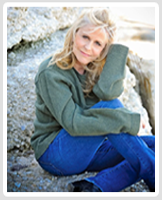I’m thoroughly convinced that one of the biggest reasons would-be authors never make it through page one of their would-be novels, is the daunting and confusing first step of choosing point-of-view. It’s something most book readers aren’t even consciously aware of, despite the fact that it hugely determines how they will relate to the characters and to the story as a whole.
First person offers a single-eye view of the world through the perspective of one character, who is also the narrator of the story. In third person, the author tells the story in an “anonymous” voice, and is afforded the advantage of tapping into more than one character’s head to convey thoughts and feelings.
For my debut novel, Wedlocked, I did not have to struggle with the decision of which view to choose. Wedlocked is based on my own true experiences, namely my impulsive, brief, and disastrous marriage after years of struggling through singlehood. Telling the story through my main character’s point-of-view was a natural choice, since Rebecca is based on me. But I soon learned of the great disadvantage of choosing first person: The story could only go as far as my protagonist’s own eyes, ears and experiences. Rebecca had to be in every scene! Luckily, I overcame this obstacle easily, as the story had Rebecca remembering the events of her life from a future place and time. Her perspective was enough to convey what I needed to, and her vibrant and witty personality carried the story with ease. However, there is something else writers of first person stories need to look out for. It’s important to make sure your tale isn’t bogged down by “I” this and “I” that. It requires some creativity to make sure you don’t fall into that annoying trap, but it’s surely doable.
In my second novel, another romantic comedy that will launch on April 25th at the World Literary Café (tune in next month for details!), I knew first person wouldn’t work nearly as well as third person. Why? Because I had three main characters into whose heads I intended to pry. Thus, I chose third person, even though the thought of it worried me. I’d never written that way before and wasn’t sure what obstacles I’d face. Would I be able to make it as funny as Wedlocked? Could I convey the distinct personalities of the main characters as clearly? Happily, the answer is yes! As the “anonymous voice” telling the story, I could still communicate the characters’ colorful personalities and humorous thoughts (albeit third hand). Dialogue wasn’t an issue because it’s the same in both point-of-views, and the advantage of not having to have my heroine in every scene was a liberating adventure for me.
Now, to complicate matters, a writer’s decision regarding point-of-view doesn’t stop there. You are also required to choose either present voice or past voice. Is the action happening “as we speak” or are the events being told from a time in the future? Most novels use past voice, probably because it’s not very common for authors to successfully employ present voice as it can be quite jarring to the reader if not used adeptly. I briefly considered using present voice for Wedlocked, but luckily after a few arduous and uncomfortable pages, came to my senses.
Now, let’s say like most authors you choose third person, past voice. Guess what? You’re still not done making point-of-view decisions. Now you need to determine if your story is going to be told in limited, objective, omniscient, or multiple POV. (See why so many writers give up before they start?) In limited, the reader is bound to just the perspective of one main character. In objective, the reader doesn’t see any of the character’s views, thoughts or feelings, but instead observes the story only from actions and details. In omniscient, the reader is privy to every character’s thoughts and feelings in the scene, a prospect that scares off many new writers. And in multiple, the reader can hear the thoughts of a few characters, as in the case of my second novel.
Just remember, you don’t have to make a final decision that is set in stone before you begin writing. I learned that it’s okay to make an educated guess as to the best view to take, and if you run into serious problems you can always go back to the beginning and change it. Trial and error is not against the rules and can be a great way to figure out the best mode of telling a story.
I think most authors still use third person because it allows for more versatility and complex storylines. Nowadays though, the use of first person seems more prevalent than ever before. Maybe that’s because a whole genre was founded on the basis of it. I am referring, of course, to Chick Lit. Ever since Bridget Jones began scrawling in her diary, millions of female readers have been swept into novels with the aid of that personal, intimate voice that speaks so well to them. The prevalence of first person has stretched beyond Chick Lit into other women’s fiction and beyond. I have been told by several readers that it was Rebecca’s wit and exasperation at her circumstances that made her so much fun as a narrator and so easy to relate to. That says a lot about the appeal of first person, but ultimately it’s your unique story that will determine which point-of-view is best.










March 21st, 2012 at 11:47 pm
Great insights! I’m experimenting on my 2nd book in my series in going from First to third depending on what is going on. My main character things are in first person. But when things are happening else where, then it is third person. I always make sure these are through separate chapters to make it easier. So far my beta readers havne’t had trouble tracking it.
March 22nd, 2012 at 3:58 pm
Hi, Bonnie: a very good post on POV. I write in first. It works well for my voice and humor. And it difficult to minimize all the “I”s and “me”s.
Thank you for sharing.
March 25th, 2012 at 1:39 am
I also experimented with POV in my novel, Michal’s Window. I wrote Michal in first person, but when it came time to do David, I thought about double first POV, like they do in some books. But somehow it didn’t feel right. I’m not a man, and describing things from a man’s POV in first was a little squirrelly, especially the love scenes.
So I settled on mixed 1st/3rd POV both deep so there is never confusion and never in the same scene. I think it worked, and no one has complained. One reviewer said it provided a nice point/counterpoint in perspectives.
Good luck with your next book! I’m sure it’ll be a hit. 🙂
April 28th, 2012 at 6:57 pm
After a 25 year career writing for television, I’m now sticking my toe in the fiction waters and POV has always been the thing that intimidated me the most. Fortunately, I’m starting with flash and short fiction. Maybe if/when I ever have a novel size idea I will have figured it out by then. Dropping by off your interview with Elizabeth Cassidy.